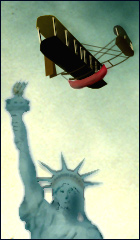The First Canoe to Fly Around the Statue of Liberty
Created | Updated Oct 20, 2009

It was an interesting trip, and at times rather exciting.
- Wilbur Wright, referring to a flight of 4 October, 1909
The Wright Brothers, Orville and Wilbur, were the innovative duo that helped to invent the modern aeroplane. They were among the first people to fly and definitely the very first to fly a canoe around the Statue of Liberty.
On 17 December, 1903, they completed a well-known flight in Kitty Hawk, North Carolina. This entry examines the somewhat less well-known, but altogether still important flights of late September and early October 1909.
As their reputation as successful pilots grew, Wilbur was approached by the Hudson-Fulton Celebration Committee, a New York group whose purpose was to celebrate 300 years of history, including Henry Hudson discovering Manhattan and Fulton testing the steam engine. The committee wanted the Wrights to demonstrate flights over the water around New York City. Orville was in Germany, so Wilbur would do the flights alone.
Interestingly, another acclaimed aviator, Glen Curtiss had agreed to participate. He had then just set the world speed record1, and the Wrights had just filed a lawsuit against him for patent infringement of their control systems. In fact, the public's anticipation was fuelled by news of the patent disputes. These flights, to the audience of nearly a million, would be a show-down between the two flyers.
Both pilots were scheduled to make a series of flights. On 29 September, 1909, Wilbur made a famous flight in the Wright Flyer III around the Statue of Liberty. To the amazement of the crowd, there was a red canoe attached to the bottom of the aeroplane's skis during this flight. If the plane went down into water, Wilbur reasoned, he could use the canoe to float himself to safety. Later on, Orville put this canoe in his house on Hawthorn Hill in Oakwood, Ohio, as it reminded him of his and his brother's flights. This first airborne canoe was more recently moved to Carillon Park in Ohio2 in the room connected to the Wright Flyer III's pit.
The Flights
On 29 September, Wilbur took off at 9.15am. This flight was in weather Curtiss had been unable to fly in. When Curtiss admitted defeat to the weather, Wilbur is supposed to have said to him, 'It looks pretty good. I think I will take a little spin in a few minutes.' He flew for about two miles, which took a little longer than seven minutes.
Later that day, Wilbur took off again, at 10.18am. He flew over a large ocean-liner and directly towards the Statue of Liberty. Many in the crowd thought that he would crash into the statue, but Wilbur rolled the plane away from it. This caused a sensation in the press, and became legendary, despite the flight lasting less than five minutes3.
Curtiss had to go to St Louis due to a prior arrangement, and was thus unable to fly. He was supposed to have flown along the Hudson River, turn around and land at Governor's Island.
On Monday, 4 October, Wilbur took off at 9.53am. He flew along the Hudson River and around Manhattan. He completed a 42-mile flight and landed at Governor's Island. This was the exact flight that Curtiss had been unable to undertake, but Wilbur finished it, and did so rather quickly.
This series of flights marked Wilbur's last to a public audience. An engine problem prevented him from doing any more in the series of flights after 5 October, and he stopped. However, his flights marked the beginning of a few new ideas. Not only were the public now interested in aviation, so were the military. Some think that when Wilbur flew over the Hudson4 it marked the beginning of aerial combat by showing the power and possibility of the aeroplane.
Wilbur was succeeded in one of these flights on 26 May, 2003. A Dayton group named Wright Flyer B Inc duplicated the flight around the Statue of Liberty with a replica of the Wright Flyer, as part of the continuing celebrations of the Wright Brothers.

